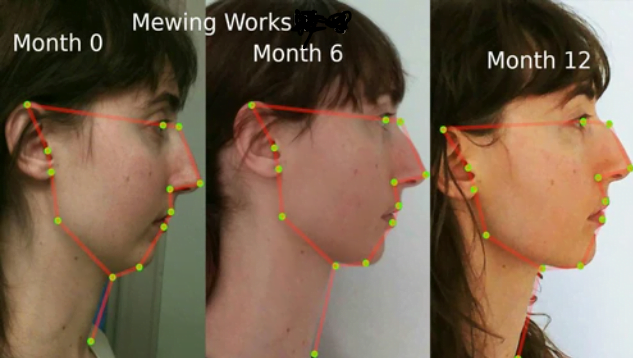Mewing: Unveiling the Science and Hype Behind the Viral Facial Trend

The internet is a breeding ground for trends, and the world of health and beauty is no exception. In recent years, a technique called “mewing” has exploded in popularity, promising to reshape your jawline and enhance your facial features through a simple tongue placement trick. But before you embark on your mewing journey, it’s crucial to understand the science behind the claims and separate fact from fiction.
What is Mewing?
Mewing refers to a facial exercise that involves resting your tongue in a specific position against the roof of your mouth. Proponents claim that maintaining this posture over time can lead to a wider jawline, improved facial structure, and even better breathing habits. The technique is named after John Mew, a British orthodontist who, along with his son Mike Mew, developed a form of orthodontics called orthotropics, which emphasizes proper tongue posture for facial development.
How to Mew: The Technique Explained
The core principle of mewing revolves around tongue placement. Here’s a breakdown of the purportedly ideal mewing posture:
- Lips Together: Gently close your lips without straining them.
- Teeth Position: Maintain a slight space between your upper and lower front teeth. Don’t clench your jaw.
- Tongue Placement: The crux of mewing lies here. Press your entire tongue firmly against the roof of your mouth. The tip should rest behind your upper front teeth, but not touching them. Imagine suctioning your tongue to the palate.
- Maintaining Posture: Hold this position throughout the day, especially when your mouth is at rest.
The Science Behind Mewing: Fact or Fiction?
While the concept of proper tongue posture has some backing in orthodontics, the scientific evidence for mewing’s effectiveness in reshaping your jawline is currently lacking. Here’s a closer look:
- Growth Plate Potential: The theory behind mewing suggests that applying gentle pressure through the tongue can influence the development of the jaw bones, particularly during childhood when these bones are still growing. However, most facial growth is complete by adulthood, making significant structural changes through mewing unlikely.
- Muscle Memory: Proponents argue that mewing strengthens and tones the jaw muscles, leading to a more sculpted appearance. While proper tongue posture can engage these muscles, there’s no robust evidence to suggest it will drastically alter your jawline.
Potential Benefits of Mewing (with a Cautionary Note)
Despite the lack of conclusive evidence for facial reshaping, there might be some potential benefits associated with proper tongue posture:
- Improved Oral Posture: Maintaining a correct tongue position can promote better oral habits like nasal breathing, which may benefit overall health.
- Myofunctional Therapy: In conjunction with professional guidance, mewing principles can be incorporated into myofunctional therapy to address issues like tongue thrusting or swallowing difficulties.
Important Considerations Before You Mew
If you’re considering trying mewing, here are some crucial points to keep in mind:
- No Substitute for Professional Care: Mewing shouldn’t be seen as a replacement for professional orthodontic treatment. If you have concerns about your jaw structure or bite, consult a qualified orthodontist.
- Unrealistic Expectations: Don’t expect dramatic changes in your jawline based solely on mewing.
- Potential Risks: Improper mewing technique could lead to jaw pain or temporomandibular joint (TMJ) dysfunction. It’s essential to prioritize proper posture and avoid excessive strain.
Mewing – A Trend with a Question Mark
While the internet is abuzz with before-and-after pictures touting mewing’s transformative power, the scientific evidence supporting its claims for facial remodeling remains unconvincing. However, proper tongue posture might offer some potential benefits for oral health and breathing habits. If you’re curious about mewing, consult a healthcare professional or a qualified orthodontist who can provide personalized guidance and ensure you’re practicing the technique safely. Remember, a healthy dose of skepticism is crucial when navigating the ever-evolving world of online health trends.
What is the mewing technique?
The mewing technique involves positioning your tongue in a specific way throughout the day, particularly at rest, with the aim of influencing your facial structure. Here’s a breakdown of the steps:
Lips Together: Gently close your lips without straining them.
Teeth Position: Maintain a slight space between your upper and lower front teeth. Avoid clenching your jaw.
Tongue Placement: This is the key aspect of mewing. Press your entire tongue firmly against the roof of your mouth. The tip of your tongue should rest behind your upper front teeth, but not touching them. Imagine creating a suction with your tongue against the palate.
Maintaining Posture: The goal is to hold this tongue position throughout the day, especially when your mouth is at rest. This can take practice and conscious effort at first.
Does mewing actually work?
There’s currently no strong scientific evidence to support the claim that mewing can significantly reshape your jawline in adulthood. Here’s a breakdown of why the science is shaky:
- Growth Plate Potential: Mewing relies on the idea that tongue pressure can influence jawbone development. This might hold some truth during childhood when these bones are still growing (growth plates are open). However, facial growth is mostly complete by adulthood, limiting mewing’s potential for major structural changes.
- Muscle Memory: Proponents argue that mewing strengthens and tones the jaw muscles, leading to a more defined jawline. While proper tongue posture can engage these muscles, there’s no robust evidence to suggest it will drastically alter your jaw shape.
However, there are some nuances to consider:
- Limited Benefits: While not a jaw-reshaping miracle, proper tongue posture could offer some potential benefits for oral health and breathing habits. Nasal breathing, which might be encouraged by mewing, can be linked to better overall health.
- Myofunctional Therapy: In conjunction with professional guidance, mewing principles can be incorporated into myofunctional therapy, which addresses issues like tongue thrusting or swallowing difficulties.
Important Considerations:
- Not a Replacement: Mewing shouldn’t replace professional orthodontic care. If you have jaw or bite concerns, consult a qualified orthodontist.
- Realistic Expectations: Dramatic jawline changes solely from mewing are unlikely.
- Potential Risks: Improper mewing technique could lead to jaw pain or temporomandibular joint (TMJ) dysfunction. Proper posture and avoiding excessive strain are crucial.
The Takeaway:
Mewing is a popular trend with limited scientific backing for its dramatic facial sculpting claims. While it might offer some potential benefits for oral health, it’s not a substitute for professional orthodontic care. If you’re curious about mewing, consult a healthcare professional or orthodontist for personalized guidance and safe practice.
Is mewing good for your face?
for more health tips click here
The potential benefits of mewing for your face are a mixed bag. Here’s a breakdown:
Possible Benefits:
- Improved Oral Posture: Maintaining a correct tongue position can promote better oral habits like nasal breathing, which may benefit overall health. This can lead to better oxygen flow and potentially improved sleep quality.
- Myofunctional Therapy: In conjunction with professional guidance from a dentist or orthodontist, mewing principles can be incorporated into myofunctional therapy. This therapy addresses issues like tongue thrusting or swallowing difficulties, which can impact oral health and facial development in children.
Uncertainties and Potential Risks:
- Limited Evidence for Facial Reshaping: There’s currently no strong scientific evidence that mewing can significantly reshape your jawline in adulthood. Most facial growth is complete by adulthood, making major structural changes unlikely.
- Muscle Memory: While proper tongue posture can engage the jaw muscles, there’s no robust evidence to suggest it will drastically alter your jaw shape.
- Potential Risks of Improper Technique: If you don’t practice mewing with proper form, you could develop jaw pain or temporomandibular joint (TMJ) dysfunction.
Overall:
If you’re looking for a quick fix to reshape your jawline, mewing likely isn’t the answer. However, proper tongue posture might offer some potential benefits for oral health and breathing habits.
Here are some things to consider before trying mewing:
- Consult a professional: It’s always best to consult with a healthcare professional or orthodontist before embarking on any new practice, especially one that involves your jaw or facial structure. They can assess your individual situation and advise you on whether mewing is appropriate.
- Focus on proper form: If you do decide to try mewing, ensure you’re practicing with proper technique to avoid any potential risks.
- Realistic expectations: Don’t expect dramatic changes in your jawline. Mewing is unlikely to deliver the dramatic results often touted online.
Remember, a healthy dose of skepticism is important when navigating online health trends
Does mewing fix your jawline?
No, there’s no convincing scientific evidence that mewing can fix your jawline in adulthood. Here’s why:
- Growth Plates: Mewing hinges on the idea that tongue pressure can influence jawbone development. This might be true for children while their growth plates (areas where bones grow) are still open. However, by adulthood, facial growth is mostly complete, limiting mewing’s impact on bone structure.
- Muscle Memory Impact: Proponents suggest mewing strengthens and tones jaw muscles, leading to a more defined jawline. While proper tongue posture can engage these muscles, there’s no strong evidence it will significantly alter your jaw shape.
However, there are some things to consider:
- Limited Benefits: While not a jaw-fixing solution, proper tongue posture could offer some potential benefits for oral health and breathing habits. Nasal breathing, which might be encouraged by mewing, can be linked to better overall health.
- Myofunctional Therapy: In a professional setting, mewing principles can be incorporated into myofunctional therapy, which addresses issues like tongue thrusting or swallowing difficulties in children. This therapy can influence facial development.
Important Considerations:
- Not a Replacement: Mewing shouldn’t replace professional orthodontic care. If you have jaw or bite concerns, consult a qualified orthodontist.
- Realistic Expectations: Dramatic jawline changes solely from mewing are unlikely.
- Potential Risks: Improper mewing technique could lead to jaw pain or temporomandibular joint (TMJ) dysfunction. Proper posture and avoiding excessive strain are crucial.
The Takeaway:
Mewing is a popular trend with limited scientific backing for its dramatic facial sculpting claims. While it might offer some potential benefits for oral health, it’s not a substitute for professional orthodontic care. If you’re curious about mewing, consult a healthcare professional or orthodontist for personalized guidance and safe practice.
mewing meme
- The “Can’t Talk, I’m Mewing” Meme
This meme features a person with their mouth closed and their tongue pressed against the roof of their mouth, as if they’re mid-mew. The caption typically reads “Can’t talk, I’m mewing” or something similar.
- The “Before and After Mewing” Meme
These memes often show a dramatic (and likely Photoshopped) transformation of someone’s jawline after supposedly mewing for a period of time. The humor comes from the absurdity of the claim.
- The “Skeleton Mewing” Meme
This meme features a skeleton with its tongue pressed against the roof of its mouth. The caption typically reads something like “Me 50 years into mewing.” It’s a funny way to poke fun at the dedication required to mew for a lifetime.
Of course, it’s important to remember that there’s no scientific evidence to support the claim that mewing can actually reshape your jawline. But that doesn’t mean it can’t be a fun way to pass the time (and maybe even improve your posture). Just don’t expect to see any major changes in your appearance.






This website has quickly become my go-to source for [topic]. The content is consistently top-notch, covering diverse angles with clarity and expertise. I’m constantly recommending it to colleagues and friends. Keep inspiring us!